Project Proposal: Online Fashion Industry Impact on Consumer Behavior
VerifiedAdded on 2020/05/28
|19
|4009
|418
Project
AI Summary
This project proposal explores the multifaceted relationship between the online fashion industry and consumer behavior. It begins with an overview of the industry's rapid growth, highlighting key trends and market dynamics in the UK, US, and China. The research aims to identify the benefits consumers derive from online fashion, investigate the factors influencing their purchasing decisions on online platforms, and analyze the overall impact of the online fashion industry on consumer behavior. The proposal outlines the research objectives, key questions, and a detailed literature review covering consumer behavior concepts, psychological, personal, and social factors. The methodology section details the research philosophy, approach, purpose, data collection, analysis techniques, sampling, and ethical considerations. The project hypothesizes a significant impact of the online fashion industry on consumer behavior and aims to provide insights into the factors that drive online fashion purchases, including visual appeal, product presentation, search functionality, and transparency in follow-up activities. The research is designed to contribute valuable insights into the evolving landscape of the online fashion industry and its profound influence on consumer choices.
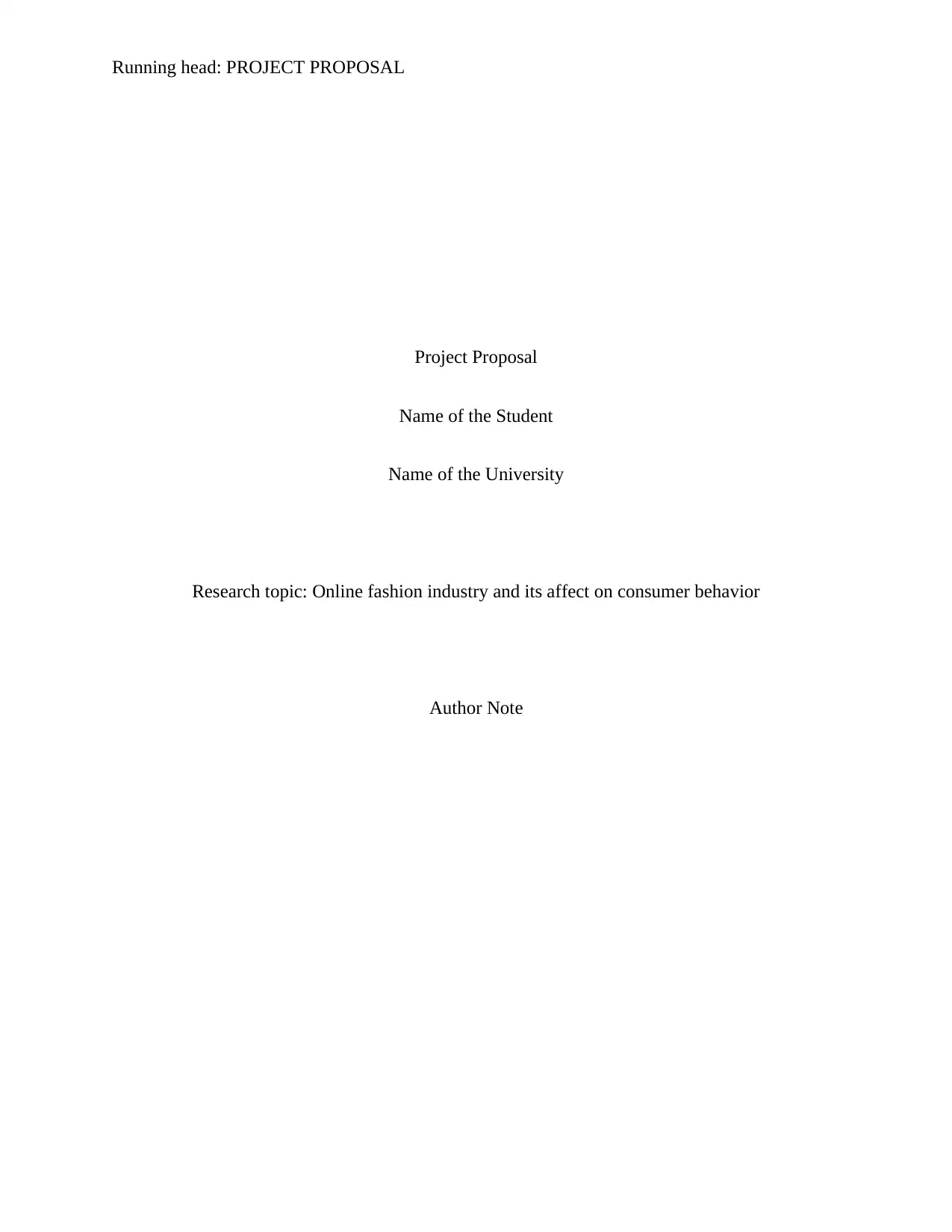
Running head: PROJECT PROPOSAL
Project Proposal
Name of the Student
Name of the University
Research topic: Online fashion industry and its affect on consumer behavior
Author Note
Project Proposal
Name of the Student
Name of the University
Research topic: Online fashion industry and its affect on consumer behavior
Author Note
Paraphrase This Document
Need a fresh take? Get an instant paraphrase of this document with our AI Paraphraser
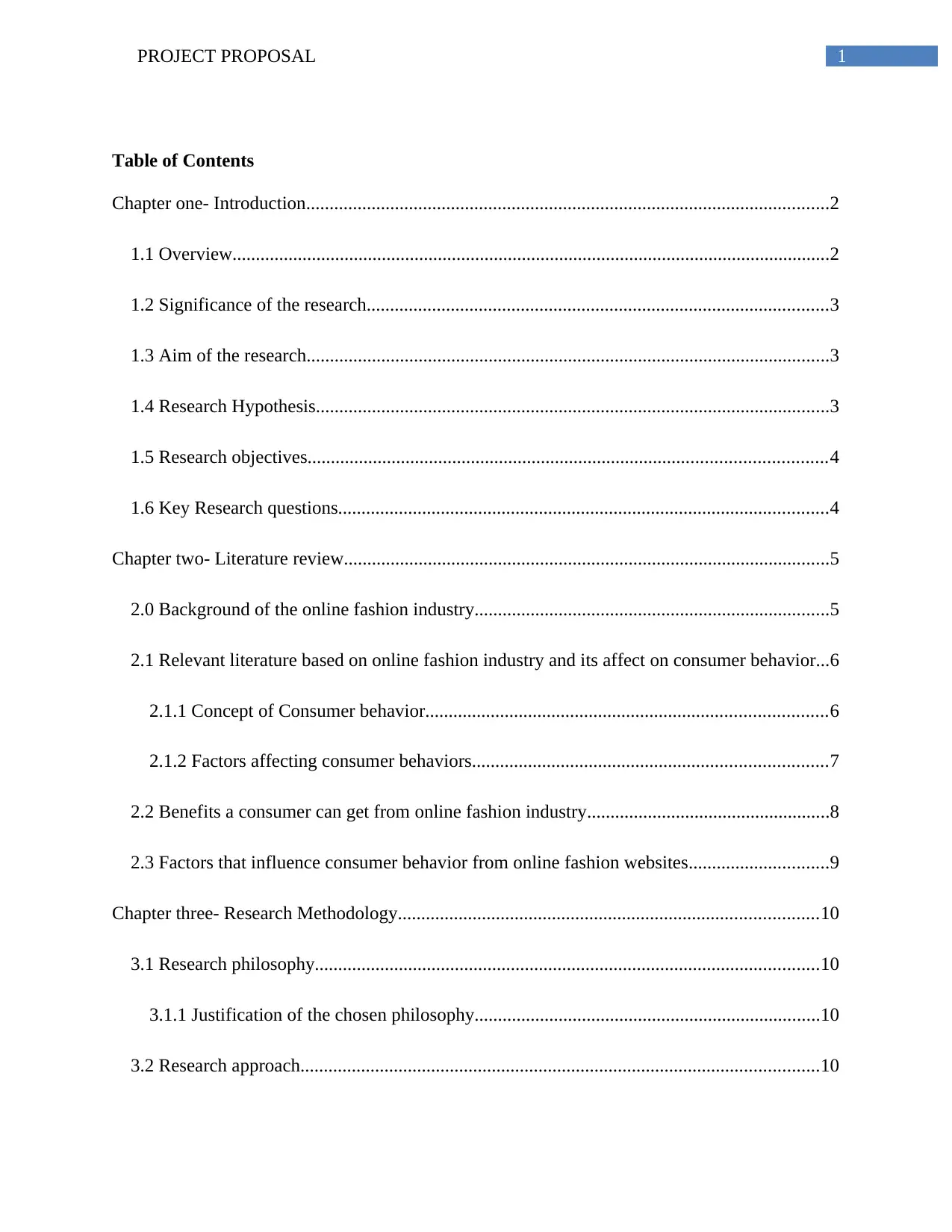
1PROJECT PROPOSAL
Table of Contents
Chapter one- Introduction................................................................................................................2
1.1 Overview................................................................................................................................2
1.2 Significance of the research...................................................................................................3
1.3 Aim of the research................................................................................................................3
1.4 Research Hypothesis..............................................................................................................3
1.5 Research objectives...............................................................................................................4
1.6 Key Research questions.........................................................................................................4
Chapter two- Literature review........................................................................................................5
2.0 Background of the online fashion industry............................................................................5
2.1 Relevant literature based on online fashion industry and its affect on consumer behavior...6
2.1.1 Concept of Consumer behavior......................................................................................6
2.1.2 Factors affecting consumer behaviors............................................................................7
2.2 Benefits a consumer can get from online fashion industry....................................................8
2.3 Factors that influence consumer behavior from online fashion websites..............................9
Chapter three- Research Methodology..........................................................................................10
3.1 Research philosophy............................................................................................................10
3.1.1 Justification of the chosen philosophy..........................................................................10
3.2 Research approach...............................................................................................................10
Table of Contents
Chapter one- Introduction................................................................................................................2
1.1 Overview................................................................................................................................2
1.2 Significance of the research...................................................................................................3
1.3 Aim of the research................................................................................................................3
1.4 Research Hypothesis..............................................................................................................3
1.5 Research objectives...............................................................................................................4
1.6 Key Research questions.........................................................................................................4
Chapter two- Literature review........................................................................................................5
2.0 Background of the online fashion industry............................................................................5
2.1 Relevant literature based on online fashion industry and its affect on consumer behavior...6
2.1.1 Concept of Consumer behavior......................................................................................6
2.1.2 Factors affecting consumer behaviors............................................................................7
2.2 Benefits a consumer can get from online fashion industry....................................................8
2.3 Factors that influence consumer behavior from online fashion websites..............................9
Chapter three- Research Methodology..........................................................................................10
3.1 Research philosophy............................................................................................................10
3.1.1 Justification of the chosen philosophy..........................................................................10
3.2 Research approach...............................................................................................................10
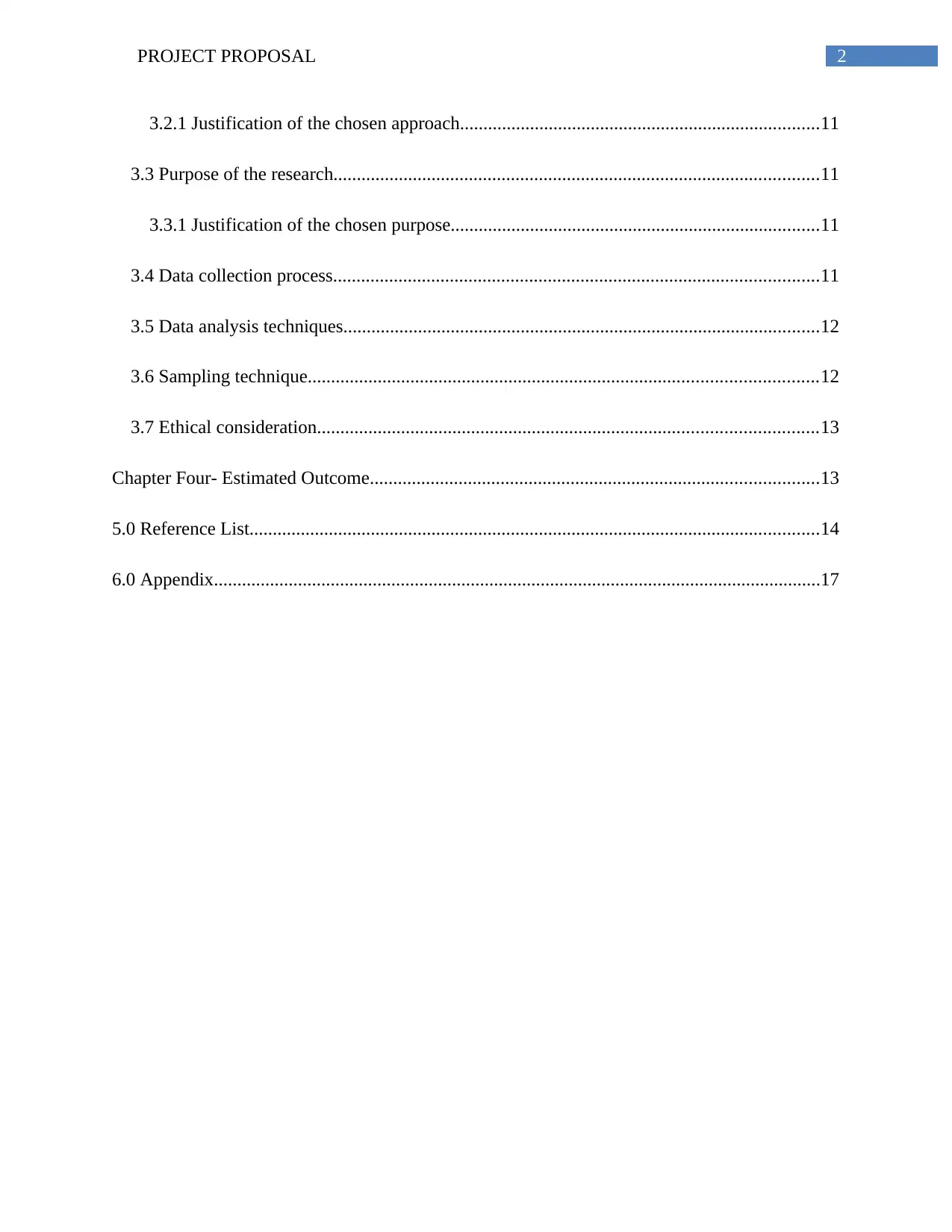
2PROJECT PROPOSAL
3.2.1 Justification of the chosen approach.............................................................................11
3.3 Purpose of the research........................................................................................................11
3.3.1 Justification of the chosen purpose...............................................................................11
3.4 Data collection process........................................................................................................11
3.5 Data analysis techniques......................................................................................................12
3.6 Sampling technique.............................................................................................................12
3.7 Ethical consideration...........................................................................................................13
Chapter Four- Estimated Outcome................................................................................................13
5.0 Reference List..........................................................................................................................14
6.0 Appendix..................................................................................................................................17
3.2.1 Justification of the chosen approach.............................................................................11
3.3 Purpose of the research........................................................................................................11
3.3.1 Justification of the chosen purpose...............................................................................11
3.4 Data collection process........................................................................................................11
3.5 Data analysis techniques......................................................................................................12
3.6 Sampling technique.............................................................................................................12
3.7 Ethical consideration...........................................................................................................13
Chapter Four- Estimated Outcome................................................................................................13
5.0 Reference List..........................................................................................................................14
6.0 Appendix..................................................................................................................................17
⊘ This is a preview!⊘
Do you want full access?
Subscribe today to unlock all pages.

Trusted by 1+ million students worldwide
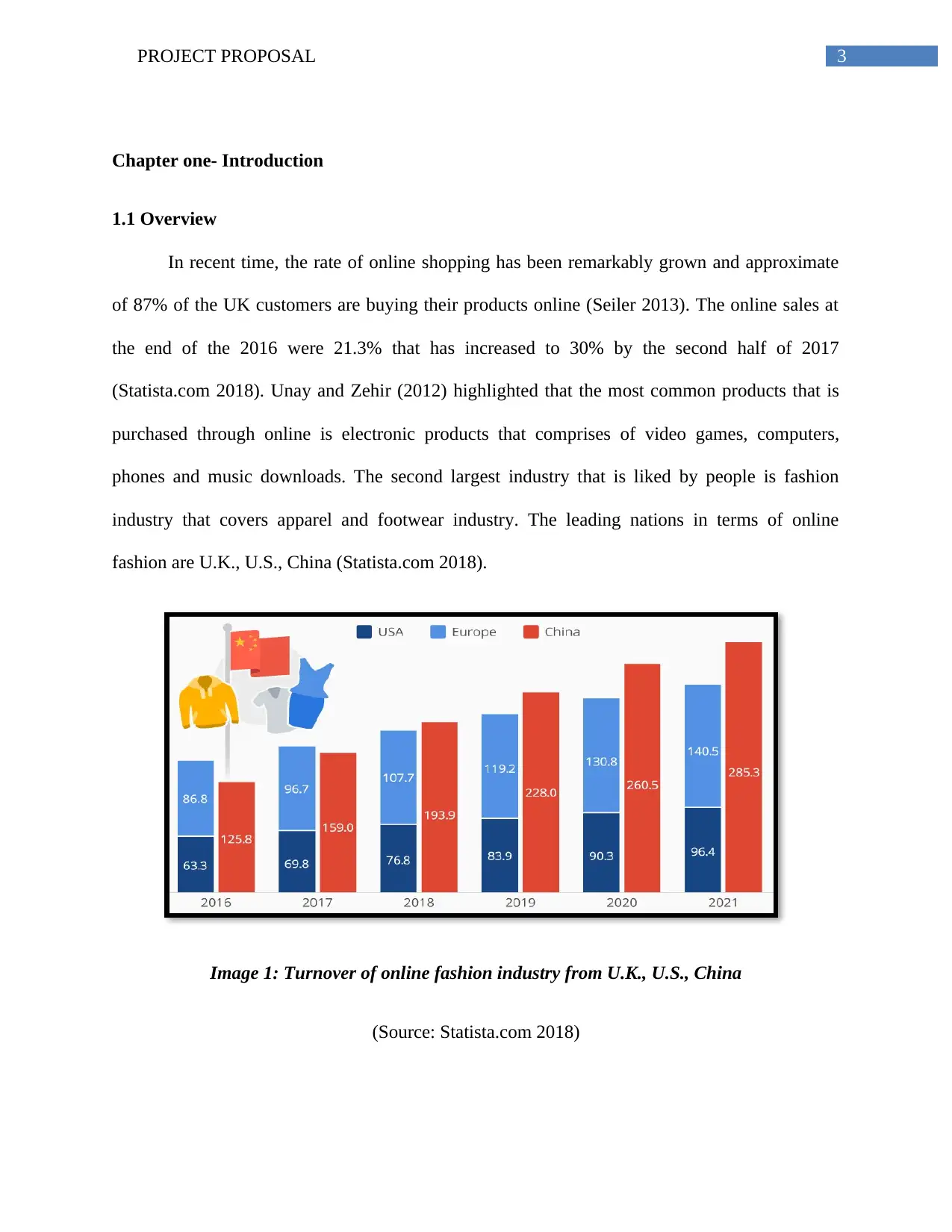
3PROJECT PROPOSAL
Chapter one- Introduction
1.1 Overview
In recent time, the rate of online shopping has been remarkably grown and approximate
of 87% of the UK customers are buying their products online (Seiler 2013). The online sales at
the end of the 2016 were 21.3% that has increased to 30% by the second half of 2017
(Statista.com 2018). Unay and Zehir (2012) highlighted that the most common products that is
purchased through online is electronic products that comprises of video games, computers,
phones and music downloads. The second largest industry that is liked by people is fashion
industry that covers apparel and footwear industry. The leading nations in terms of online
fashion are U.K., U.S., China (Statista.com 2018).
Image 1: Turnover of online fashion industry from U.K., U.S., China
(Source: Statista.com 2018)
Chapter one- Introduction
1.1 Overview
In recent time, the rate of online shopping has been remarkably grown and approximate
of 87% of the UK customers are buying their products online (Seiler 2013). The online sales at
the end of the 2016 were 21.3% that has increased to 30% by the second half of 2017
(Statista.com 2018). Unay and Zehir (2012) highlighted that the most common products that is
purchased through online is electronic products that comprises of video games, computers,
phones and music downloads. The second largest industry that is liked by people is fashion
industry that covers apparel and footwear industry. The leading nations in terms of online
fashion are U.K., U.S., China (Statista.com 2018).
Image 1: Turnover of online fashion industry from U.K., U.S., China
(Source: Statista.com 2018)
Paraphrase This Document
Need a fresh take? Get an instant paraphrase of this document with our AI Paraphraser
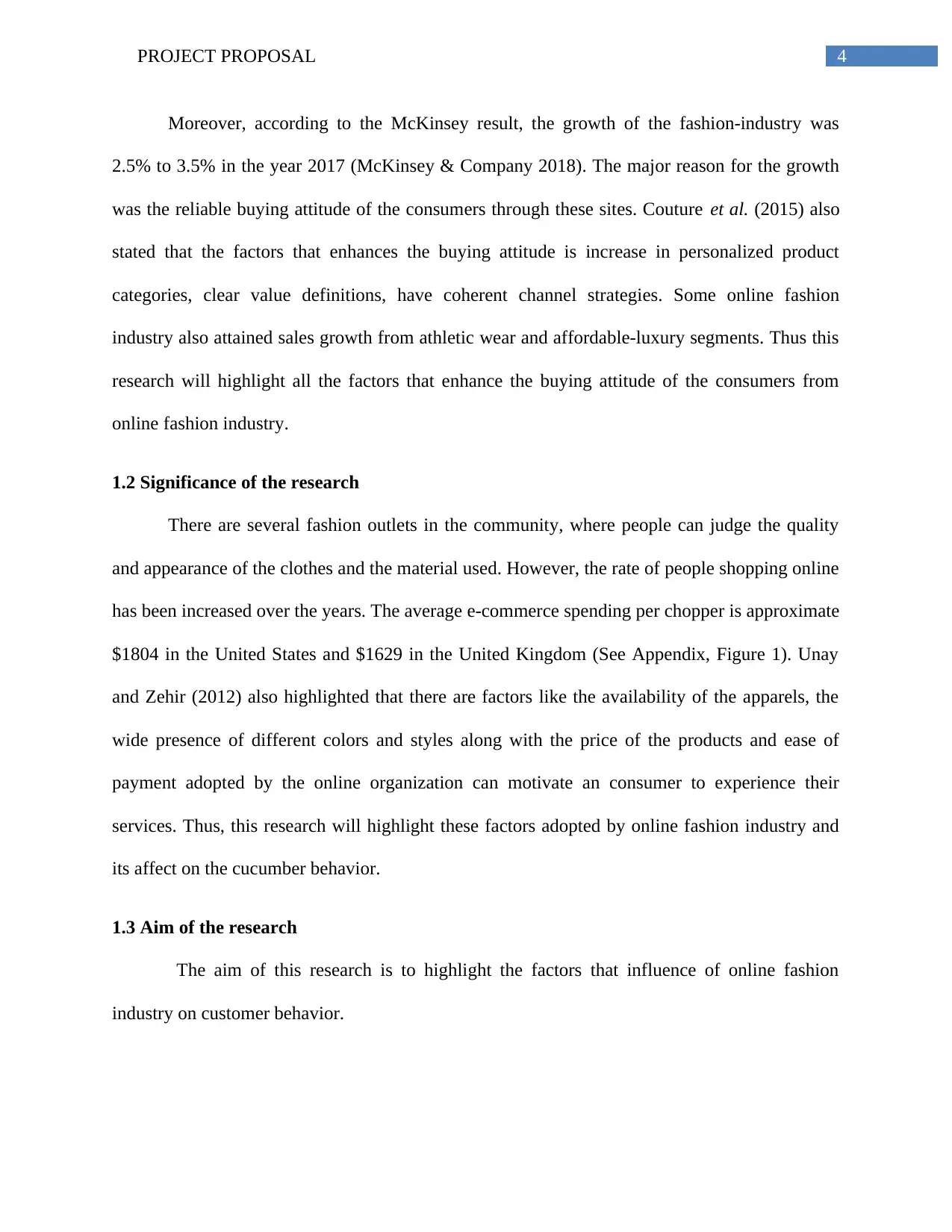
4PROJECT PROPOSAL
Moreover, according to the McKinsey result, the growth of the fashion-industry was
2.5% to 3.5% in the year 2017 (McKinsey & Company 2018). The major reason for the growth
was the reliable buying attitude of the consumers through these sites. Couture et al. (2015) also
stated that the factors that enhances the buying attitude is increase in personalized product
categories, clear value definitions, have coherent channel strategies. Some online fashion
industry also attained sales growth from athletic wear and affordable-luxury segments. Thus this
research will highlight all the factors that enhance the buying attitude of the consumers from
online fashion industry.
1.2 Significance of the research
There are several fashion outlets in the community, where people can judge the quality
and appearance of the clothes and the material used. However, the rate of people shopping online
has been increased over the years. The average e-commerce spending per chopper is approximate
$1804 in the United States and $1629 in the United Kingdom (See Appendix, Figure 1). Unay
and Zehir (2012) also highlighted that there are factors like the availability of the apparels, the
wide presence of different colors and styles along with the price of the products and ease of
payment adopted by the online organization can motivate an consumer to experience their
services. Thus, this research will highlight these factors adopted by online fashion industry and
its affect on the cucumber behavior.
1.3 Aim of the research
The aim of this research is to highlight the factors that influence of online fashion
industry on customer behavior.
Moreover, according to the McKinsey result, the growth of the fashion-industry was
2.5% to 3.5% in the year 2017 (McKinsey & Company 2018). The major reason for the growth
was the reliable buying attitude of the consumers through these sites. Couture et al. (2015) also
stated that the factors that enhances the buying attitude is increase in personalized product
categories, clear value definitions, have coherent channel strategies. Some online fashion
industry also attained sales growth from athletic wear and affordable-luxury segments. Thus this
research will highlight all the factors that enhance the buying attitude of the consumers from
online fashion industry.
1.2 Significance of the research
There are several fashion outlets in the community, where people can judge the quality
and appearance of the clothes and the material used. However, the rate of people shopping online
has been increased over the years. The average e-commerce spending per chopper is approximate
$1804 in the United States and $1629 in the United Kingdom (See Appendix, Figure 1). Unay
and Zehir (2012) also highlighted that there are factors like the availability of the apparels, the
wide presence of different colors and styles along with the price of the products and ease of
payment adopted by the online organization can motivate an consumer to experience their
services. Thus, this research will highlight these factors adopted by online fashion industry and
its affect on the cucumber behavior.
1.3 Aim of the research
The aim of this research is to highlight the factors that influence of online fashion
industry on customer behavior.
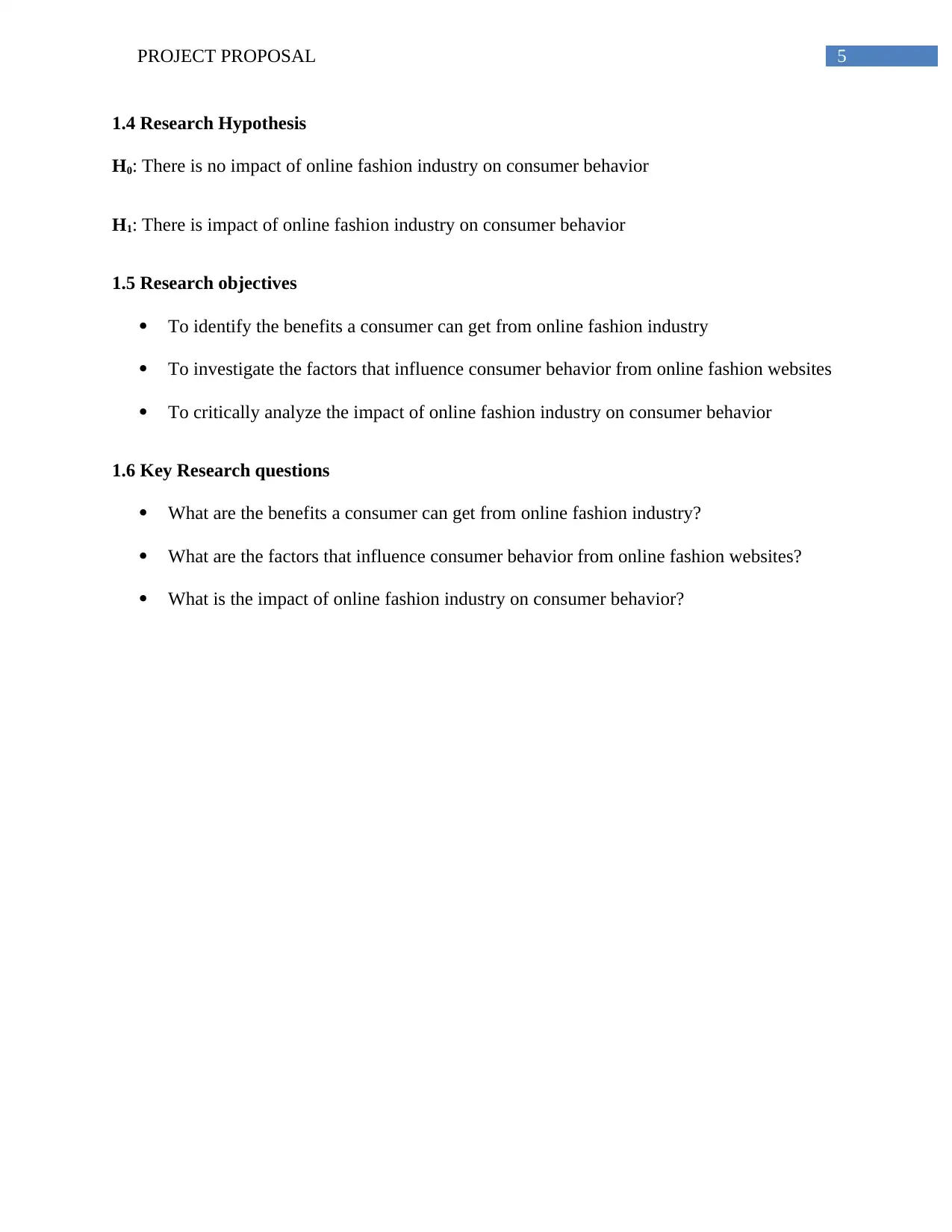
5PROJECT PROPOSAL
1.4 Research Hypothesis
H0: There is no impact of online fashion industry on consumer behavior
H1: There is impact of online fashion industry on consumer behavior
1.5 Research objectives
To identify the benefits a consumer can get from online fashion industry
To investigate the factors that influence consumer behavior from online fashion websites
To critically analyze the impact of online fashion industry on consumer behavior
1.6 Key Research questions
What are the benefits a consumer can get from online fashion industry?
What are the factors that influence consumer behavior from online fashion websites?
What is the impact of online fashion industry on consumer behavior?
1.4 Research Hypothesis
H0: There is no impact of online fashion industry on consumer behavior
H1: There is impact of online fashion industry on consumer behavior
1.5 Research objectives
To identify the benefits a consumer can get from online fashion industry
To investigate the factors that influence consumer behavior from online fashion websites
To critically analyze the impact of online fashion industry on consumer behavior
1.6 Key Research questions
What are the benefits a consumer can get from online fashion industry?
What are the factors that influence consumer behavior from online fashion websites?
What is the impact of online fashion industry on consumer behavior?
⊘ This is a preview!⊘
Do you want full access?
Subscribe today to unlock all pages.

Trusted by 1+ million students worldwide
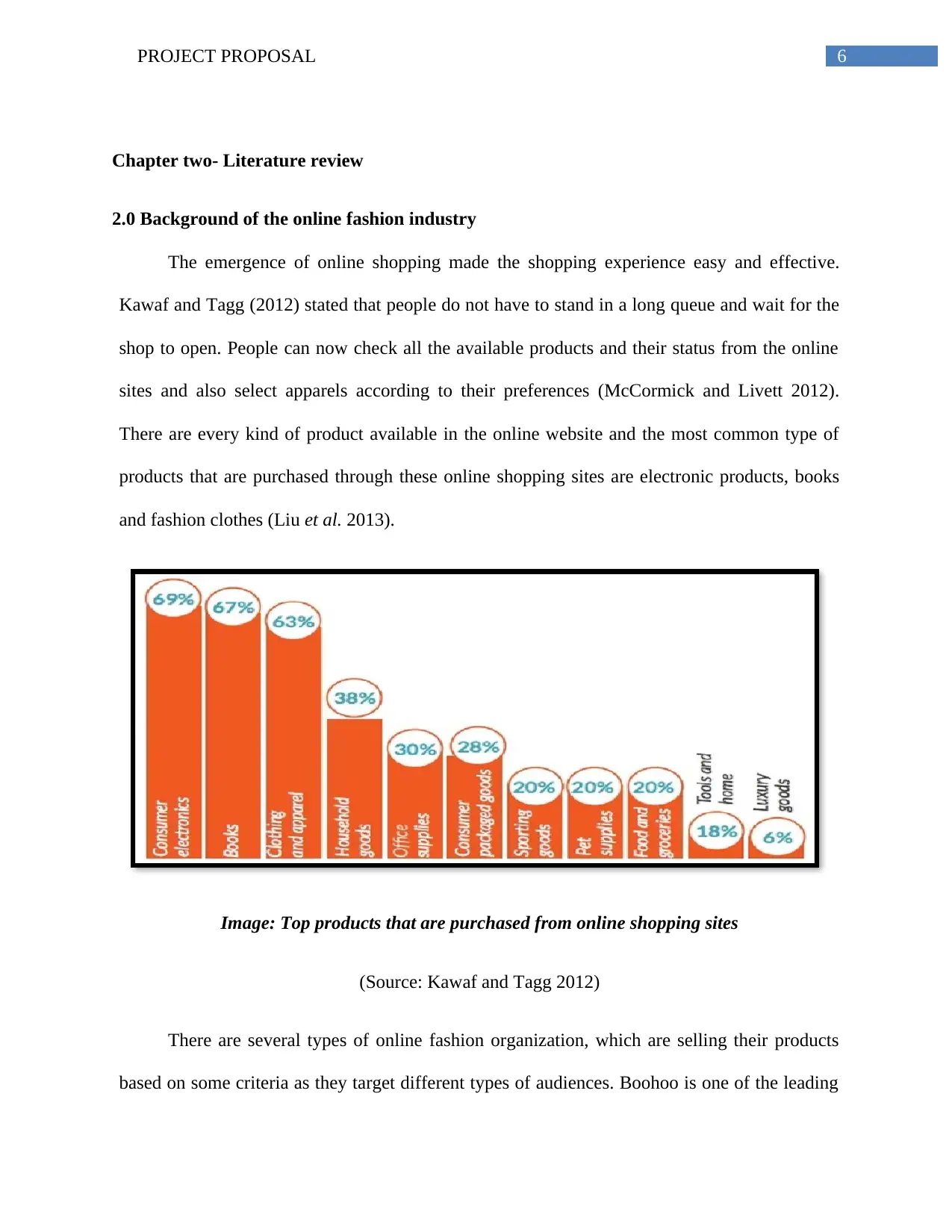
6PROJECT PROPOSAL
Chapter two- Literature review
2.0 Background of the online fashion industry
The emergence of online shopping made the shopping experience easy and effective.
Kawaf and Tagg (2012) stated that people do not have to stand in a long queue and wait for the
shop to open. People can now check all the available products and their status from the online
sites and also select apparels according to their preferences (McCormick and Livett 2012).
There are every kind of product available in the online website and the most common type of
products that are purchased through these online shopping sites are electronic products, books
and fashion clothes (Liu et al. 2013).
Image: Top products that are purchased from online shopping sites
(Source: Kawaf and Tagg 2012)
There are several types of online fashion organization, which are selling their products
based on some criteria as they target different types of audiences. Boohoo is one of the leading
Chapter two- Literature review
2.0 Background of the online fashion industry
The emergence of online shopping made the shopping experience easy and effective.
Kawaf and Tagg (2012) stated that people do not have to stand in a long queue and wait for the
shop to open. People can now check all the available products and their status from the online
sites and also select apparels according to their preferences (McCormick and Livett 2012).
There are every kind of product available in the online website and the most common type of
products that are purchased through these online shopping sites are electronic products, books
and fashion clothes (Liu et al. 2013).
Image: Top products that are purchased from online shopping sites
(Source: Kawaf and Tagg 2012)
There are several types of online fashion organization, which are selling their products
based on some criteria as they target different types of audiences. Boohoo is one of the leading
Paraphrase This Document
Need a fresh take? Get an instant paraphrase of this document with our AI Paraphraser
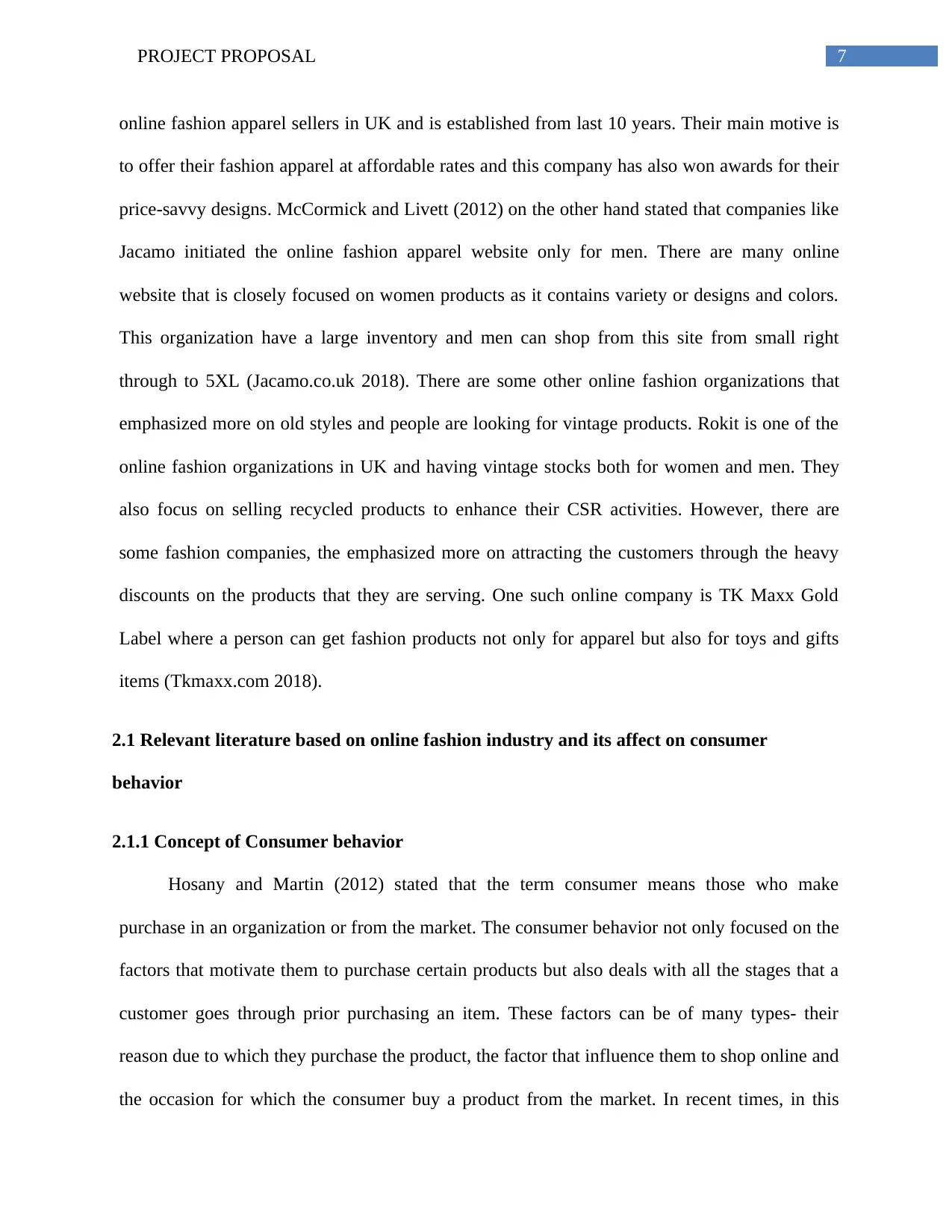
7PROJECT PROPOSAL
online fashion apparel sellers in UK and is established from last 10 years. Their main motive is
to offer their fashion apparel at affordable rates and this company has also won awards for their
price-savvy designs. McCormick and Livett (2012) on the other hand stated that companies like
Jacamo initiated the online fashion apparel website only for men. There are many online
website that is closely focused on women products as it contains variety or designs and colors.
This organization have a large inventory and men can shop from this site from small right
through to 5XL (Jacamo.co.uk 2018). There are some other online fashion organizations that
emphasized more on old styles and people are looking for vintage products. Rokit is one of the
online fashion organizations in UK and having vintage stocks both for women and men. They
also focus on selling recycled products to enhance their CSR activities. However, there are
some fashion companies, the emphasized more on attracting the customers through the heavy
discounts on the products that they are serving. One such online company is TK Maxx Gold
Label where a person can get fashion products not only for apparel but also for toys and gifts
items (Tkmaxx.com 2018).
2.1 Relevant literature based on online fashion industry and its affect on consumer
behavior
2.1.1 Concept of Consumer behavior
Hosany and Martin (2012) stated that the term consumer means those who make
purchase in an organization or from the market. The consumer behavior not only focused on the
factors that motivate them to purchase certain products but also deals with all the stages that a
customer goes through prior purchasing an item. These factors can be of many types- their
reason due to which they purchase the product, the factor that influence them to shop online and
the occasion for which the consumer buy a product from the market. In recent times, in this
online fashion apparel sellers in UK and is established from last 10 years. Their main motive is
to offer their fashion apparel at affordable rates and this company has also won awards for their
price-savvy designs. McCormick and Livett (2012) on the other hand stated that companies like
Jacamo initiated the online fashion apparel website only for men. There are many online
website that is closely focused on women products as it contains variety or designs and colors.
This organization have a large inventory and men can shop from this site from small right
through to 5XL (Jacamo.co.uk 2018). There are some other online fashion organizations that
emphasized more on old styles and people are looking for vintage products. Rokit is one of the
online fashion organizations in UK and having vintage stocks both for women and men. They
also focus on selling recycled products to enhance their CSR activities. However, there are
some fashion companies, the emphasized more on attracting the customers through the heavy
discounts on the products that they are serving. One such online company is TK Maxx Gold
Label where a person can get fashion products not only for apparel but also for toys and gifts
items (Tkmaxx.com 2018).
2.1 Relevant literature based on online fashion industry and its affect on consumer
behavior
2.1.1 Concept of Consumer behavior
Hosany and Martin (2012) stated that the term consumer means those who make
purchase in an organization or from the market. The consumer behavior not only focused on the
factors that motivate them to purchase certain products but also deals with all the stages that a
customer goes through prior purchasing an item. These factors can be of many types- their
reason due to which they purchase the product, the factor that influence them to shop online and
the occasion for which the consumer buy a product from the market. In recent times, in this
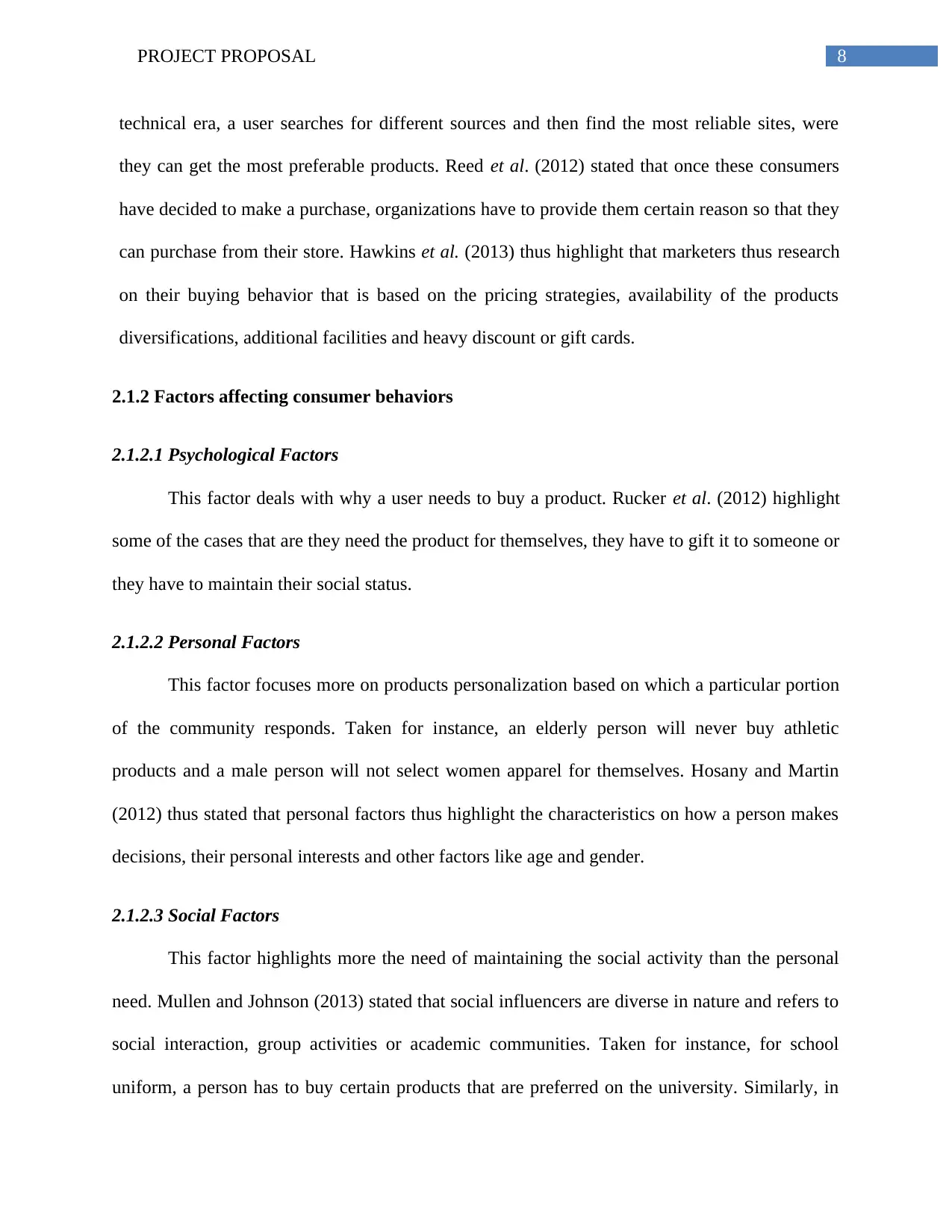
8PROJECT PROPOSAL
technical era, a user searches for different sources and then find the most reliable sites, were
they can get the most preferable products. Reed et al. (2012) stated that once these consumers
have decided to make a purchase, organizations have to provide them certain reason so that they
can purchase from their store. Hawkins et al. (2013) thus highlight that marketers thus research
on their buying behavior that is based on the pricing strategies, availability of the products
diversifications, additional facilities and heavy discount or gift cards.
2.1.2 Factors affecting consumer behaviors
2.1.2.1 Psychological Factors
This factor deals with why a user needs to buy a product. Rucker et al. (2012) highlight
some of the cases that are they need the product for themselves, they have to gift it to someone or
they have to maintain their social status.
2.1.2.2 Personal Factors
This factor focuses more on products personalization based on which a particular portion
of the community responds. Taken for instance, an elderly person will never buy athletic
products and a male person will not select women apparel for themselves. Hosany and Martin
(2012) thus stated that personal factors thus highlight the characteristics on how a person makes
decisions, their personal interests and other factors like age and gender.
2.1.2.3 Social Factors
This factor highlights more the need of maintaining the social activity than the personal
need. Mullen and Johnson (2013) stated that social influencers are diverse in nature and refers to
social interaction, group activities or academic communities. Taken for instance, for school
uniform, a person has to buy certain products that are preferred on the university. Similarly, in
technical era, a user searches for different sources and then find the most reliable sites, were
they can get the most preferable products. Reed et al. (2012) stated that once these consumers
have decided to make a purchase, organizations have to provide them certain reason so that they
can purchase from their store. Hawkins et al. (2013) thus highlight that marketers thus research
on their buying behavior that is based on the pricing strategies, availability of the products
diversifications, additional facilities and heavy discount or gift cards.
2.1.2 Factors affecting consumer behaviors
2.1.2.1 Psychological Factors
This factor deals with why a user needs to buy a product. Rucker et al. (2012) highlight
some of the cases that are they need the product for themselves, they have to gift it to someone or
they have to maintain their social status.
2.1.2.2 Personal Factors
This factor focuses more on products personalization based on which a particular portion
of the community responds. Taken for instance, an elderly person will never buy athletic
products and a male person will not select women apparel for themselves. Hosany and Martin
(2012) thus stated that personal factors thus highlight the characteristics on how a person makes
decisions, their personal interests and other factors like age and gender.
2.1.2.3 Social Factors
This factor highlights more the need of maintaining the social activity than the personal
need. Mullen and Johnson (2013) stated that social influencers are diverse in nature and refers to
social interaction, group activities or academic communities. Taken for instance, for school
uniform, a person has to buy certain products that are preferred on the university. Similarly, in
⊘ This is a preview!⊘
Do you want full access?
Subscribe today to unlock all pages.

Trusted by 1+ million students worldwide
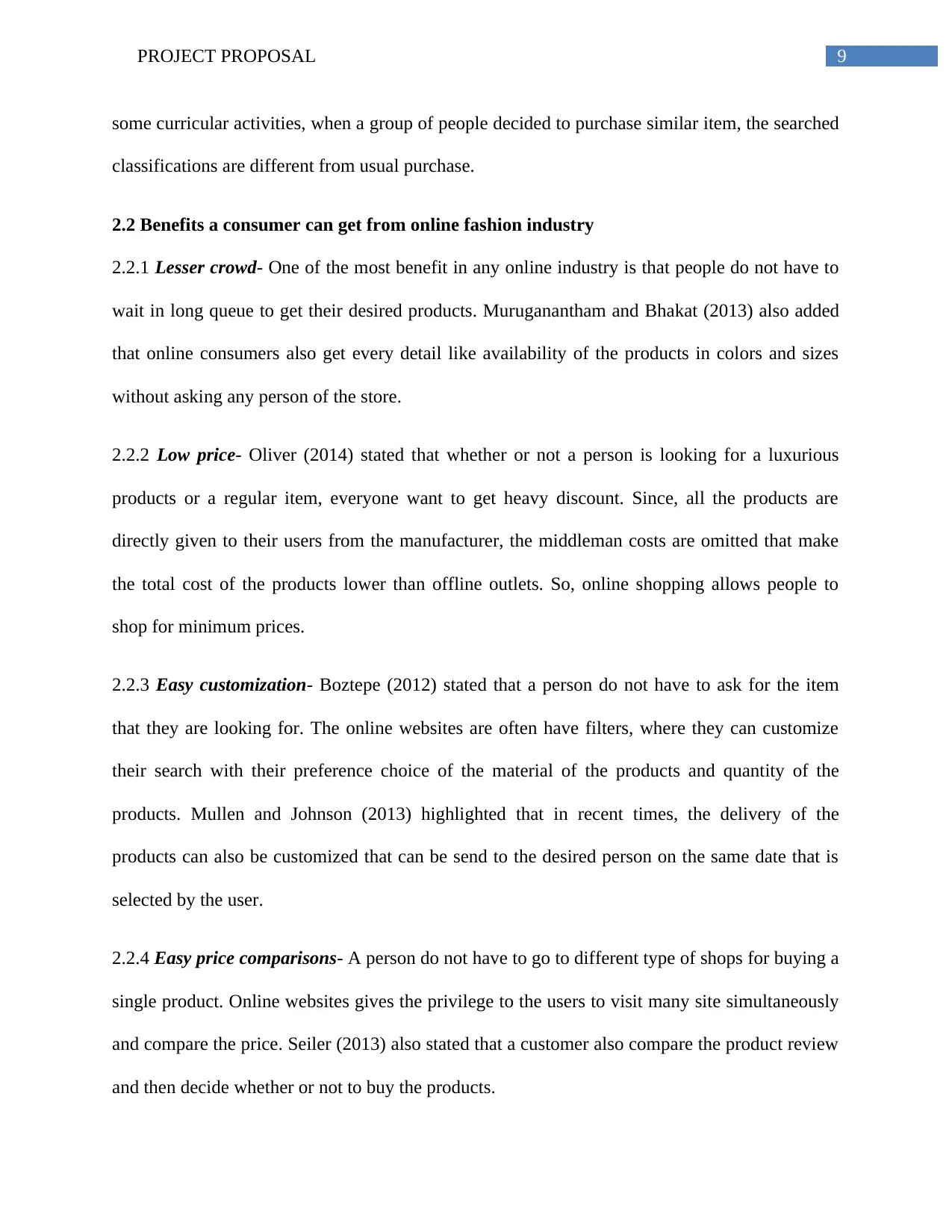
9PROJECT PROPOSAL
some curricular activities, when a group of people decided to purchase similar item, the searched
classifications are different from usual purchase.
2.2 Benefits a consumer can get from online fashion industry
2.2.1 Lesser crowd- One of the most benefit in any online industry is that people do not have to
wait in long queue to get their desired products. Muruganantham and Bhakat (2013) also added
that online consumers also get every detail like availability of the products in colors and sizes
without asking any person of the store.
2.2.2 Low price- Oliver (2014) stated that whether or not a person is looking for a luxurious
products or a regular item, everyone want to get heavy discount. Since, all the products are
directly given to their users from the manufacturer, the middleman costs are omitted that make
the total cost of the products lower than offline outlets. So, online shopping allows people to
shop for minimum prices.
2.2.3 Easy customization- Boztepe (2012) stated that a person do not have to ask for the item
that they are looking for. The online websites are often have filters, where they can customize
their search with their preference choice of the material of the products and quantity of the
products. Mullen and Johnson (2013) highlighted that in recent times, the delivery of the
products can also be customized that can be send to the desired person on the same date that is
selected by the user.
2.2.4 Easy price comparisons- A person do not have to go to different type of shops for buying a
single product. Online websites gives the privilege to the users to visit many site simultaneously
and compare the price. Seiler (2013) also stated that a customer also compare the product review
and then decide whether or not to buy the products.
some curricular activities, when a group of people decided to purchase similar item, the searched
classifications are different from usual purchase.
2.2 Benefits a consumer can get from online fashion industry
2.2.1 Lesser crowd- One of the most benefit in any online industry is that people do not have to
wait in long queue to get their desired products. Muruganantham and Bhakat (2013) also added
that online consumers also get every detail like availability of the products in colors and sizes
without asking any person of the store.
2.2.2 Low price- Oliver (2014) stated that whether or not a person is looking for a luxurious
products or a regular item, everyone want to get heavy discount. Since, all the products are
directly given to their users from the manufacturer, the middleman costs are omitted that make
the total cost of the products lower than offline outlets. So, online shopping allows people to
shop for minimum prices.
2.2.3 Easy customization- Boztepe (2012) stated that a person do not have to ask for the item
that they are looking for. The online websites are often have filters, where they can customize
their search with their preference choice of the material of the products and quantity of the
products. Mullen and Johnson (2013) highlighted that in recent times, the delivery of the
products can also be customized that can be send to the desired person on the same date that is
selected by the user.
2.2.4 Easy price comparisons- A person do not have to go to different type of shops for buying a
single product. Online websites gives the privilege to the users to visit many site simultaneously
and compare the price. Seiler (2013) also stated that a customer also compare the product review
and then decide whether or not to buy the products.
Paraphrase This Document
Need a fresh take? Get an instant paraphrase of this document with our AI Paraphraser
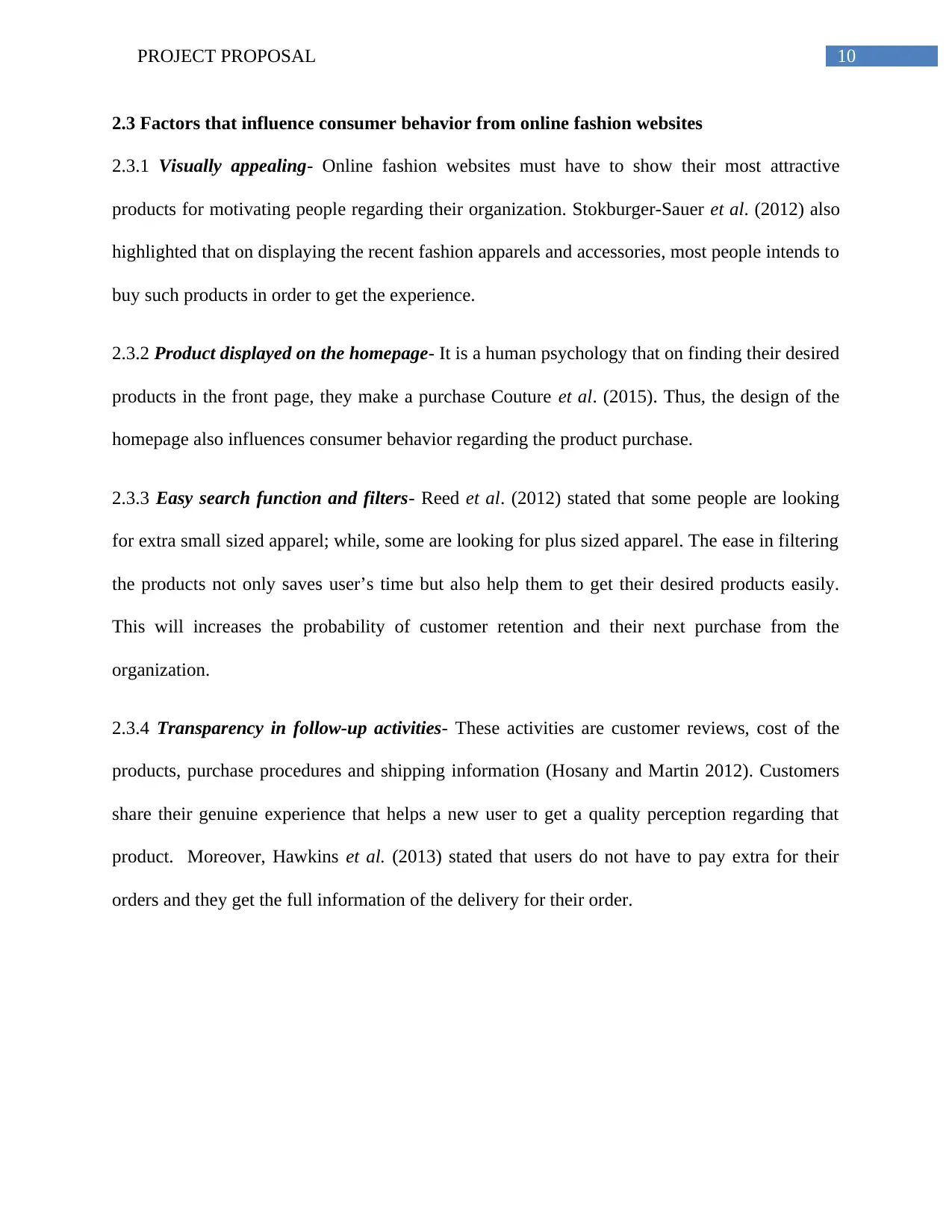
10PROJECT PROPOSAL
2.3 Factors that influence consumer behavior from online fashion websites
2.3.1 Visually appealing- Online fashion websites must have to show their most attractive
products for motivating people regarding their organization. Stokburger-Sauer et al. (2012) also
highlighted that on displaying the recent fashion apparels and accessories, most people intends to
buy such products in order to get the experience.
2.3.2 Product displayed on the homepage- It is a human psychology that on finding their desired
products in the front page, they make a purchase Couture et al. (2015). Thus, the design of the
homepage also influences consumer behavior regarding the product purchase.
2.3.3 Easy search function and filters- Reed et al. (2012) stated that some people are looking
for extra small sized apparel; while, some are looking for plus sized apparel. The ease in filtering
the products not only saves user’s time but also help them to get their desired products easily.
This will increases the probability of customer retention and their next purchase from the
organization.
2.3.4 Transparency in follow-up activities- These activities are customer reviews, cost of the
products, purchase procedures and shipping information (Hosany and Martin 2012). Customers
share their genuine experience that helps a new user to get a quality perception regarding that
product. Moreover, Hawkins et al. (2013) stated that users do not have to pay extra for their
orders and they get the full information of the delivery for their order.
2.3 Factors that influence consumer behavior from online fashion websites
2.3.1 Visually appealing- Online fashion websites must have to show their most attractive
products for motivating people regarding their organization. Stokburger-Sauer et al. (2012) also
highlighted that on displaying the recent fashion apparels and accessories, most people intends to
buy such products in order to get the experience.
2.3.2 Product displayed on the homepage- It is a human psychology that on finding their desired
products in the front page, they make a purchase Couture et al. (2015). Thus, the design of the
homepage also influences consumer behavior regarding the product purchase.
2.3.3 Easy search function and filters- Reed et al. (2012) stated that some people are looking
for extra small sized apparel; while, some are looking for plus sized apparel. The ease in filtering
the products not only saves user’s time but also help them to get their desired products easily.
This will increases the probability of customer retention and their next purchase from the
organization.
2.3.4 Transparency in follow-up activities- These activities are customer reviews, cost of the
products, purchase procedures and shipping information (Hosany and Martin 2012). Customers
share their genuine experience that helps a new user to get a quality perception regarding that
product. Moreover, Hawkins et al. (2013) stated that users do not have to pay extra for their
orders and they get the full information of the delivery for their order.
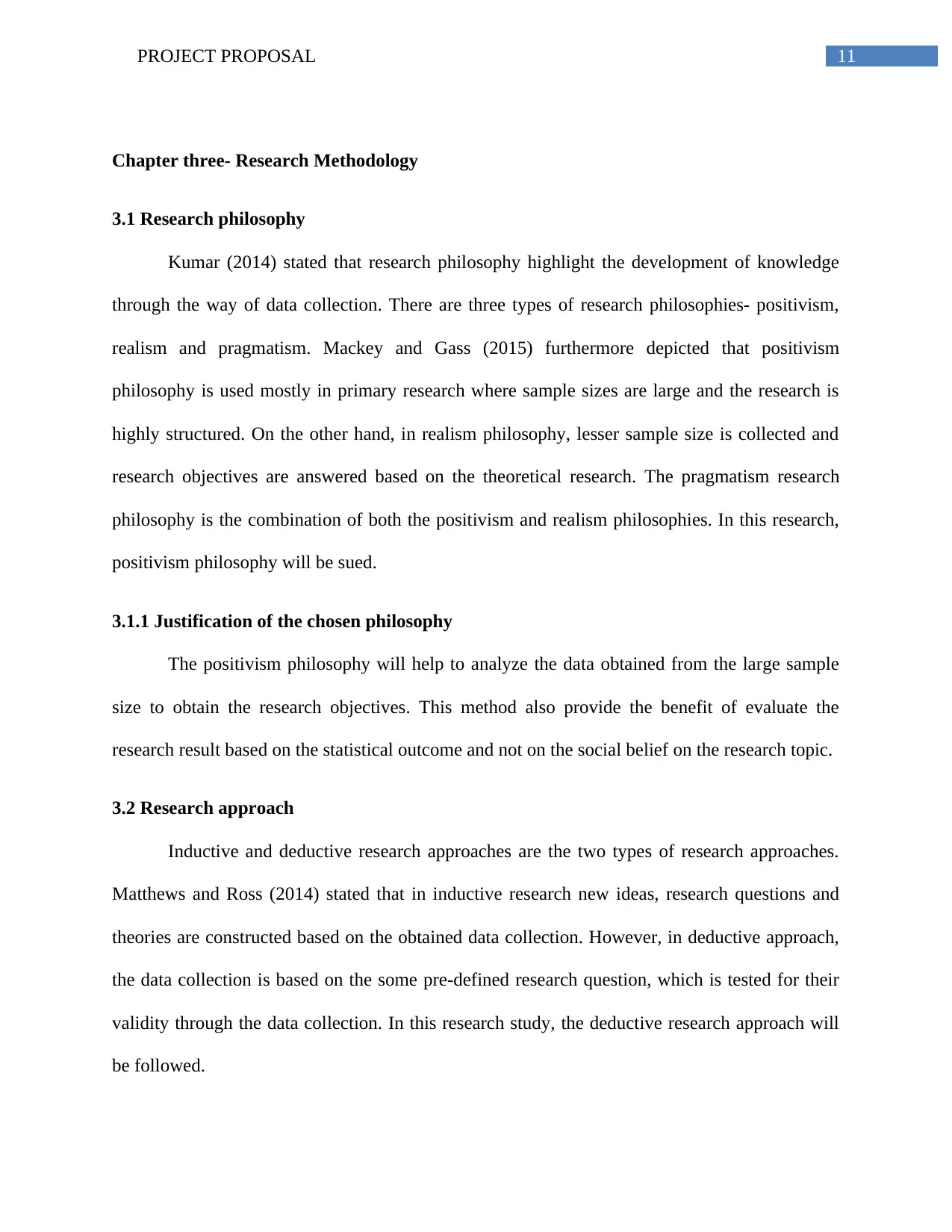
11PROJECT PROPOSAL
Chapter three- Research Methodology
3.1 Research philosophy
Kumar (2014) stated that research philosophy highlight the development of knowledge
through the way of data collection. There are three types of research philosophies- positivism,
realism and pragmatism. Mackey and Gass (2015) furthermore depicted that positivism
philosophy is used mostly in primary research where sample sizes are large and the research is
highly structured. On the other hand, in realism philosophy, lesser sample size is collected and
research objectives are answered based on the theoretical research. The pragmatism research
philosophy is the combination of both the positivism and realism philosophies. In this research,
positivism philosophy will be sued.
3.1.1 Justification of the chosen philosophy
The positivism philosophy will help to analyze the data obtained from the large sample
size to obtain the research objectives. This method also provide the benefit of evaluate the
research result based on the statistical outcome and not on the social belief on the research topic.
3.2 Research approach
Inductive and deductive research approaches are the two types of research approaches.
Matthews and Ross (2014) stated that in inductive research new ideas, research questions and
theories are constructed based on the obtained data collection. However, in deductive approach,
the data collection is based on the some pre-defined research question, which is tested for their
validity through the data collection. In this research study, the deductive research approach will
be followed.
Chapter three- Research Methodology
3.1 Research philosophy
Kumar (2014) stated that research philosophy highlight the development of knowledge
through the way of data collection. There are three types of research philosophies- positivism,
realism and pragmatism. Mackey and Gass (2015) furthermore depicted that positivism
philosophy is used mostly in primary research where sample sizes are large and the research is
highly structured. On the other hand, in realism philosophy, lesser sample size is collected and
research objectives are answered based on the theoretical research. The pragmatism research
philosophy is the combination of both the positivism and realism philosophies. In this research,
positivism philosophy will be sued.
3.1.1 Justification of the chosen philosophy
The positivism philosophy will help to analyze the data obtained from the large sample
size to obtain the research objectives. This method also provide the benefit of evaluate the
research result based on the statistical outcome and not on the social belief on the research topic.
3.2 Research approach
Inductive and deductive research approaches are the two types of research approaches.
Matthews and Ross (2014) stated that in inductive research new ideas, research questions and
theories are constructed based on the obtained data collection. However, in deductive approach,
the data collection is based on the some pre-defined research question, which is tested for their
validity through the data collection. In this research study, the deductive research approach will
be followed.
⊘ This is a preview!⊘
Do you want full access?
Subscribe today to unlock all pages.

Trusted by 1+ million students worldwide
1 out of 19
Your All-in-One AI-Powered Toolkit for Academic Success.
+13062052269
info@desklib.com
Available 24*7 on WhatsApp / Email
![[object Object]](/_next/static/media/star-bottom.7253800d.svg)
Unlock your academic potential
Copyright © 2020–2025 A2Z Services. All Rights Reserved. Developed and managed by ZUCOL.